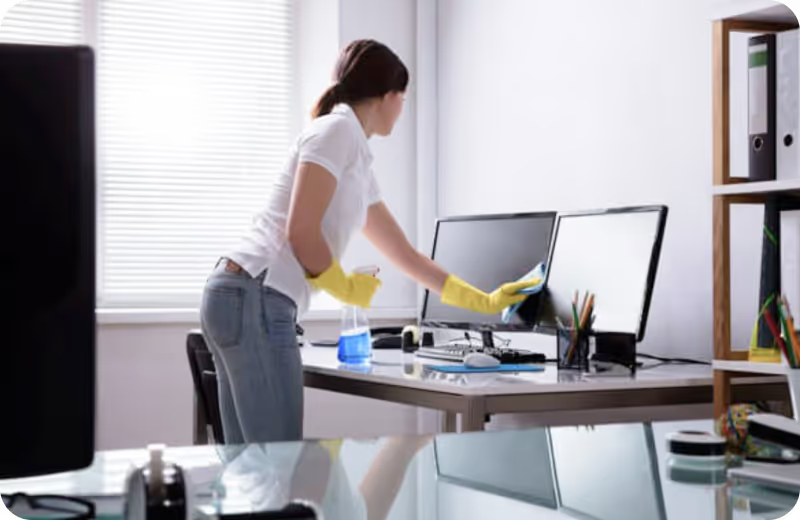
Your kitchen sponge does the majority of the cleaning in your pantry. You use it to wash greasy food off your plates, and you may even use the sponge to clean your oven. As sponges meet with much of the kitchen grime, it can easily harbor germs and bacteria that feed off food bits left in the sponge. Mold grows in moist environments, so your sponge can harbor mold too!
We often change sponges every few weeks, but between sponge changes, it is important to keep your kitchen sponge clean and disinfected. Here's how you can clean your kitchen sponge daily, regardless of what material your sponge is made of:
What You'll Need
For a basic clean, you only need to use hot, boiling water to rinse out the germs and harmful bacteria from your kitchen sponge. However, you can also use bleach or vinegar for a deeper clean, especially for kitchen sponges that have gone through large amounts of grime.
- Hot water
- Chlorine bleach OR
- Full-strength vinegar and salt
- Kitchen sink
How to Clean a Sponge: A Step-by-step Guide
Step 1: Wash the Sponge
Cleaning a dirty sponge starts with a good rinse. Rinsing with some dish soap would remove any dirt and food bits that are stuck in the sponge. We recommend you wash the sponge with some warm water to melt any oils and grease to make them easier to dissolve. Wring the sponge thoroughly to remove any excess water.
You can, alternatively, use the dishwasher to clean a sponge. Place the sponge on the top rack of your dishwasher, and let the machine run on its warm or hot setting. This will keep your kitchen sponge clean alongside the rest of your dishes, but it may not thoroughly remove bacteria without a proper disinfectant.
Step 2: Disinfect the Sponge
The next step is to disinfect the sponge. There are three ways to clean a sponge: using boiling water, using bleach, and using vinegar. Choose one or the other to sanitize your sponge. You should disinfect your sponge daily, especially if you use the same sponge for multiple areas in the kitchen.
Using Boiling Water
Using boiling water is the most effective way to disinfect your kitchen sponge. Boil some water over the stove or in the microwave, and pour it directly over your kitchen sponge. You can also submerge the sponge in a bowl of freshly-boiled water. Let the sponge soak in the boiling water, and let the water cool completely before taking the sponge out.
Using Bleach
You can also disinfect the sponge with bleach. Mix together 1/2 a teaspoon of chlorine bleach in a quart of warm water, and submerge the sponge in the solution. Let the solution cool before taking the sponge out. Wring out the excess solution, and use gloves to safely handle the sponge if you have sensitive skin.
Using Vinegar
Vinegar and salt can get rid of common germs from your sponge, and is a safer option than using bleach or boiling water. However, vinegar and salt may not completely clean kitchen sponges, especially as their disinfecting properties are milder than bleach.
However, vinegar and salt is the food-safe way to clean your sponge if you don't fancy using bleach, or handling boiling water. Simply soak your sponge in a mixture of warm vinegar and salt. Both ingredients should kill any mold from your sponge, as well as the bacteria thriving inside.
Step 3: Rinse and Air Dry
After disinfecting your sponge, it is best to rinse away any cleaning solution that you've used. If you disinfect your sponge using boiling water, then you no longer have to rinse the material. For the bleach or vinegar solution, however, rinse the sponge under running water to remove any residue.
Let the sponge air dry, or place it on the drying rack of your dishwasher for a heated dry. Store the dry sponge away from moisture, and you should have a fully-cleaned kitchen sponge that is ready to tackle your dinner plates!
Natural Alternatives to Kitchen Sponge
Most kitchen sponges are made from plastic foam, which never biodegrades, and can be difficult to clean even with boiling water and bleach. Sponges also do not last long, so you will end up disposing of multiple sponges in just one year. Stick to natural alternatives like loofa, natural sponges, and coconut coir scrubbers in the kitchen.
Because they are much more sustainable, you can easily toss out an old sponge without feeling guilty about harming the environment. Doing so will ensure you're using only the most sanitized scrubbers to clean your plates. Natural alternatives are also easier to clean, as most natural materials do not melt under hot or boiling water like plastic sponges do.
Go for Kitchen Cleaning
Cleaning your sponge in the kitchen is not enough to keep your home dirt-free. When it's time for your annual spring cleaning, go for our services at Luce SG for a hassle-free way to complete your cleaning chores! Our expert cleaners will know how to clean, sanitize, and disinfect each area of your home.
Give us a call today, and we can discuss a home cleaning service routine that works for you!





























